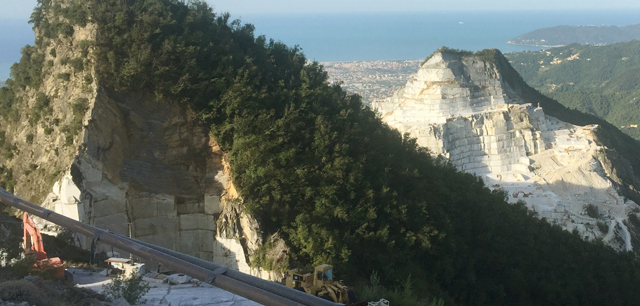DISCOVER THE MARBLES OF CARRARA

One of the most common questions we are asked is how many varieties of the Carrara marble can be distinguished. In order to be able to answer, it must first be recalled that the materials known as “Carrara marbles” are mined from a large region in northwestern Tuscany that belongs to the Apuan Alps mountain range which, in turn, consists of five mining areas: Carrara, Massa, Lunigiana, Garfagnana and Versilia.
The Carrara area is where mining was started by the ancient Romans as early as the 1st century B.C., and its mining capacity is three times the total output from the other four areas. This is why Carrara is so famous that all materials extracted from the region of the Apuan Alps are worldwide known as the “Carrara marble”.

Mining areas are divided into many marble basins. For example, the Carrara area divides into four basins: Pescina-Boccanaglia, Torano, Fantiscritti-Miseglia and Colonnata. Each basin has its “active quarries” (currently in operation) and “inactive quarries” (those in which the mining process has been stopped). For example, the Fantiscritti-Miseglia basin comprises 30 active quarries and the Colonnata basin 29. Given that one quarry produces several varieties of marble, it is quickly understood that the deposits of the Apuan Alps deliver hundreds of types of stone.
Despite such a large number of varieties, there are only a few names that are known all over the world.
It is, therefore, natural that people may wonder why materials with a different appearance are sold under the same names, such as Bianco Carrara, Venato or Calacatta. If you are interested in understanding the causes of the situation, we invite you to learn a few facts.
1) Traditional names, the ones used by the inhabitants of Carrara to describe and sell their marbles, are much more numerous than you might think. Here are some examples: Ordinario or Bianco Ordinario, Bianco Venato, Bianco Macchiato, Venato, Macchiato, Bianco Statuario, Statuario Venato, Statuario Macchiato, Paonazzo or Pavonazzo, Paonazzetto or Pavonazzetto, Bardiglio, Cipollino, Fiorito, Misiarchio, Bianco Chiarchio, Ordinco Chiarchio, Calacatta or Calacata, Arabescato, Brouillè, Cipollino Zebrato or Cipollino Zebrino or Zebrino, Bianco P.
The adjective “traditional” describes both names from hundreds of years ago (such as Ordinario, Venato, Statuario, Paonazzo, Bardiglio) and those introduced at the turn of the 19th and 20th centuries (Calacatta / Calacata, Arabescato). From the second half of the 20th century on, some Carrara retailers promoted the names so far known and used only within their community, e.g. Venatino, Statuarietto.
2) The traditional names were originally associated with a key attribute of each marble, namely its appearance, quality or suitability for a particular project. A noteworthy exception is the name Calacatta which was derived from a Carrara region called Calacata.
3) The traditional names were coined to distinguish between the main varieties of marble quarried in the Apuan Alps. Each variety exists in several or more than a dozen subtypes, the name of which is formed by combining the name of the main variety with another term, sometimes referring to a characteristic feature of the material, or else to the name of the quarry or place of origin.
4) Some of the traditional names have disappeared from the stonework dictionary (e.g. Macchiato, Statuario Macchiato, or Fiorito), and the materials they referred to have been given new terms.
5) The naming of Apuan marble takes on a variety of meanings depending on when, where and by whom it is used so that one name can have multiple meanings.
6) Whenever a name is commonly associated with nice, good quality material (you could say it has become something of a “brand”), there are always vendors who refer to it as materials that actually hardly resemble the original version.
7) Whenever there is a marble on the market that has not been mined on a large scale before, many people tend to compare it with one of the known types, even though the two materials do not have much in common. Thus, the “new” variety takes the name of an existing material.
8) A large number of stone importers all over the world use the name “Bianco Carrara” or only “Carrara” to denote most of the Carrara marble they offer. This is a big mistake that has led to much misunderstanding over the years.
Source: Kurier kamieniarski
Author: Omnistone.pl | Published: 18 December 2019
